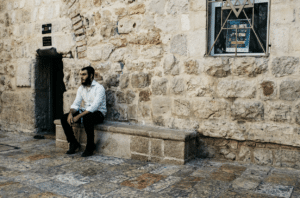“Some Christians will find it shocking… while others will be comforted by the idea of it being a traditional part of Judaism,” suggests Daniel Boyarin, a professor of Talmudic culture at the University of California at Berkeley, talking about an archeological discovery, found close to the Dead Sea around the year 2000 [1].
Unlike the Dead Sea Scrolls, however, this ancient text is written in ink onto a stone tablet, and gives evidence of an ancient Jewish belief that the Messiah would die and come back to life on the third day.
It is not so easy to demonstrate that the Messiah would rise from the dead using the Jewish Scriptures alone, but we know that Paul the Apostle was able to do just that.
“As was his custom, Paul went to the Jewish people; and for three Shabbatot, he debated the Scriptures with them. He opened them and gave evidence that Messiah had to suffer and rise from the dead, saying, “This Yeshua, whom I declare to you, is the Messiah.”” (Acts 17:2-3)
And Paul was not the only one – we now know that there were other Jewish people in the first century BCE who were anticipating the same thing, based on Biblical prophecy. The so called Gabriel Stone gives us some insight into that belief.
What is on the stone?
Like the Dead Sea Scrolls, which were found in the mid twentieth century, the ancient stone tablet continues to create debate long after its discovery over fifteen years ago. However, it wasn’t until quite recently that Jewish scholars have been examining the stone more earnestly, and causing a ruckus with their controversial findings that point to Yeshua fitting the bill of existing Jewish Messianic expectations of his time.
The tablet is thought to be from the first century BC, shortly before Yeshua came in the flesh. Dealing with themes of apocalyse and end times prophecy, based on Daniel, Haggai and Zechariah, it has come to be known as “Gabriel’s Vision” or “Gabriel’s Revelation” because it is written in the first person in the name of Gabriel. The 87 lines of text, divided into two columns, are not all easy to read, and some of the words are simply impossible to make out. However, more experts have in recent years devoted time and attention to unravelling the mystery and discovering not only what is written, but also what it meant.
Two of the key experts involved are Ada Yardeni, an Israeli scholar and world authority on ancient Semitic languages, and another textual scholar called Israel Knohl from Hebrew University. Both agree that the text talks about the idea of a Messiah figure coming back to life. Yardeni writes,
“After reviewing the document, I came to the conclusion that the reading suggested by Professor Knohl for the third word of line 80—HAYE “live”—seems to be the only plausible reading of that word. Thus, the first five words of this line should be translated as: “In three days live.” [2]
Rising on the third day
This is an extraordinary discovery, because it shows us that this idea of resurrection on the third day existed in Jewish thinking even before Yeshua. Indeed, we can see that Jonah’s experience in the belly of the whale and Esther’s three-day fast in the face of annihation give us two “types” of this death and resurrection theme within the three day period, along with numerous other “third day” clues, but this tablet shows us that these thoughts in connection with the Messiah; the “Prince of Princes”.
There are hints in Psalm 22 and Isaiah 53 that the Messiah would not only be killed, but would rise again afterwards, and there is the passage in Hosea 6:1-2 about a third day resurrection:
Come, let us return to Adonai.
For He has torn, but He will heal us.
He has smitten, but He will bind us up.
After two days He will revive us.
On the third day He will raise us up,
and we will live in His presence.
There are two ideas of messiah common in Jewish thought – one from the line of David, who was traditionally expected win a political and military victory, and one would would be a son of Joseph, who would suffer and die. Although these ideas predate Yeshua, the idea of a messianic son of Joseph continued long after Jesus. Indeed, expectations that he would come from the north Galilee region and lead his disciples down to Jerusalem, and that he would suffer and die, were strongly held even in the sixteenth century. [3]
Again, it is important to note that the mystery is not entirely solved. There are many details that remain unknown, and words that still have not been decyphered, but it is wonderful that many top academics are having to contemplate the possibility that the death and third day resurrection of Yeshua, son of Joseph, from the line of David, might not be as alien to Judaism as they thought.
[1] NY Times, July 6, 2008 “Ancient Tablet Ignites Debate on Messiah and Resurrection”, Ethan Bronner
[2] BAR Magazine,“Dead Sea Scroll in Stone”: Yardeni Agrees with Knohl’s Reading”
[3] Yair Paz, Schecter Institute of Jewish Studies, Israel: Holy Inhabitants Of A Holy City: How Safed Became One Of The Four Holy Cities Of Eretz Israel In The Sixteenth Century (Introduction pp.243-248)
To see an English translation of what’s written on the Gabriel Stone, click here















